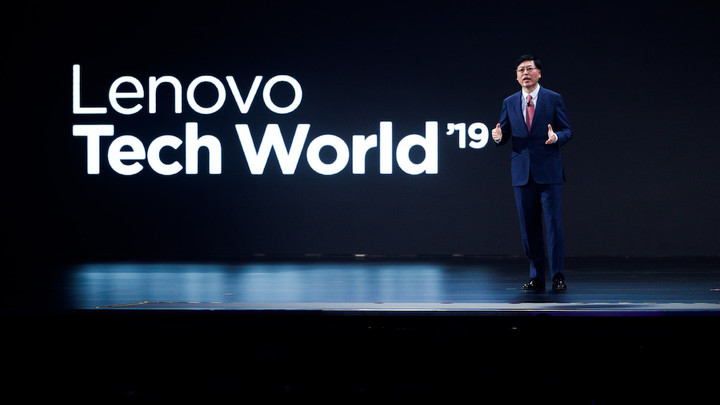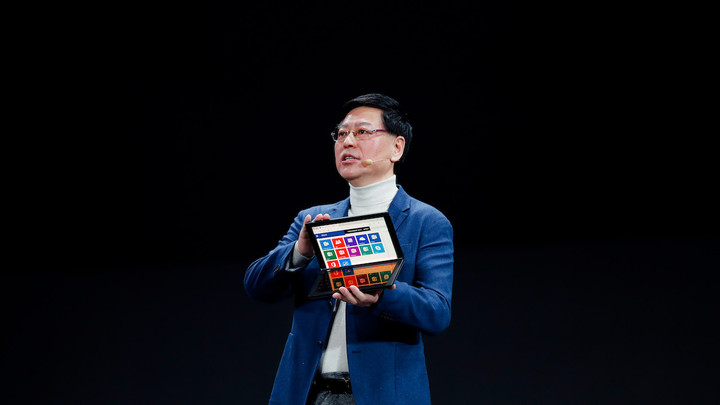In 1984, Ni Guangnan and Liu Chuanzhi held a company of 200,000 yuan from the Institute of Computing Technology of the Chinese Academy of Sciences, and founded a company in South Road, Haidian District, Beijing. Their first product is called “Hanka.” Today, people who know what it is are not so young.
In the past 35 years, today’s Lenovo has grown into a giant with an annual revenue of 350 billion yuan and 57,000 employees worldwide. As a company, 35 years old is like entering middle age. It seems that it should be stable and steady. In contrast, Lenovo’s frequent actions in recent years are first of all the “three-wave strategy” of step by step, focusing on the intelligent “3S strategy” and brand new brand. The vision, it can be seen that Lenovo has increasingly stepped out of the past, and has taken a new path without hesitation.
This was even more evident at the 5th Lenovo Innovation and Technology Conference held on November 14.
Building, design and construction of “Smart Building”, Lenovo is all-inclusive

On the 14th Industrial Intelligence Daily Forum, Lenovo Chairman and CEO Yang Yuanqing said in his opening speech:
If we say that the first two years we are still trying to open the “brain hole” to imagine the bright future of the intelligent era, then today, we can conclude that the future has come, we have entered a The intelligent era of data intelligence driving industry change.
In other words, the meaning is very clear: Lenovo has completely seen the trend of intelligence, and has decided to embark on the road of intelligence.
For this intelligent era that has arrived, Lenovo’s attitude can be said to be “all in”.
In the B-side business, Lenovo proposed the “end-edge-cloud-network-intelligence” architecture. “End” is a smart IoT device terminal, “edge” is edge computing, “cloud” is cloud computing, “net” is a data transmission network represented by 5G, and “edge-cloud-net” constitutes the basis of intelligence. Architecture. And “smart” refers to the industry’s smart solutions.
For Lenovo, this architecture is not a slogan. Behind it is Lenovo’s rich accumulation of technology, products and even industry customers.
A demonstration by Lenovo Senior Vice President and CTO Yong Yong at the conference site, we can see Lenovo’s confidence in technology accumulation.
A plane model is placed on one side of the venue. A Lenovo employee holds a camera and scans around the model. After walking around the original point, the real-time 3D modeling of the venue screen is displayed. On the screen, the marker points also return to the origin. The three-dimensional model of the entire aircraft was instantly depicted.
Corresponding to the first S (Smart IoT) is a smart IoT terminal. To do terminal products is Lenovo’s housekeeping skills. For computers, tablets, and mobile phones, Lenovo needs to do cross-device collaboration, natural language interaction, and actively adapt to user needs. At the same time, it is still around the smart manufacturing, smart city, smart healthcare, smart retail and other scenarios, developers use IoT terminals.

▲ The world’s first folding screen laptop ThinkPad X1 Image from: Lenovo
The second S (Smart Infrastructure), which is the intelligent infrastructure, is the “edge-cloud-network” collaborative infrastructure. Lenovo has low-power, high-performance, edge computing servers and edge computing cloud platforms that are designed to withstand harsh environments. The private cloud in cloud computing is Lenovo’s traditional advantage, and the association of public cloud is quite capable. As for the network, Lenovo has applied for 638 5G patented technologies, 5G computers and 5G mobile phones, and has also established a cloud network convergence division specializing in 5G technologies and applications.
And the third S (Smart Vertical) industry intelligence is Lenovo’s true ambition.
In this regard, Yang Yuanqing made an analogy: If the intelligent transformation of all walks of life is likened to building a smart building, then the smart terminal and intelligent infrastructure are building materials. What Lenovo is doing in this regard is to produce various “prefabricated parts” for building a building. With the construction materials, there is also a “designer” to draw the drawings, and then the “construction team” enters the building. In the whole industry, there are different companies in these parts, but there are often specializations in the industry. Materials may not be designed. Designing construction is not necessarily the case. Lenovo’s approach is: I want it all.
This waywardness may not be unreasonable. Since 2016, Lenovo has provided intelligent solutions for hundreds of large enterprise customers, including automotive, 3C, energy and other industries to help them achieve more accurate business insight and decision-making.

▲Wind generators. Image from: unsplash
Yang Yuanqing said that Lenovo has deployed an end-to-end solution for a large wind power company in China, collecting more than 1500 points of data in wind power equipment in real time, and analyzing the data on-site with Lenovo’s edge computing gateway. The abnormal information is transmitted back to the center’s industrial Internet platform, through which hundreds of wind power plants can be remotely maintained.
The result is increased fan utilization and power generation efficiency, and operating costs are reduced by more than 5%.
Another smart building, Lenovo also wants to contract
The personal consumer business is another broad battlefield for intelligence. Lenovo proposed the “DeeeP” architecture in this section, with the intention of establishing another “personal intelligence building.”
“D” is a smart device, and the turnover of Lenovo is growing at a rate of 4-5 times a year. The three “e” are the cross-device collaboration engine, data management and application service ecosystem, which are used to realize the characteristics of the future personal intelligent life scene described by Yang Yuanqing: personal data synchronization, device interconnection and interoperability. With a “D” and three “e”, there is a “P” – a personal intelligence experience.
Jia Zhaohui, senior vice president of Lenovo Group and global consumer business, demonstrated Lenovo’s Lenovo One device collaboration engine.
A Android phone and a Windows laptop are put together. The “One Connection” function allows the two to connect quickly. The mobile phone is immediately projected on the right side of the laptop screen, which is equivalent to a computer screen for a mobile phone. The “divided” function allows different screens to be displayed on the “mobile phone” and the mobile phone screen on the computer screen. Lenovo is said to be the first company in the industry to achieve this. “Airborne” has made a very interesting attempt in the interaction: the phone taps on the palm of your hand, and the photo is transmitted to the computer in seconds.
The Lenovo One device collaboration engine opens up multiple layers of device drivers, basic connectivity and transport protocols, and application frameworks. Current productStill in the first phase, focusing on the synergy between the computer and the phone, it will be extended to more types of devices.
The cross-device collaborative interaction on the ThinkPad should be loved by a lot of efficiency control: after connecting the extended screen, the switch between the ThinkPad screen and the extended screen can be achieved with a partial head tilt, which screen is biased toward the head. The screen is activated.

▲ moto RAZR folding screen phone.
The scene also shows the return to the classic folding screen mobile phone moto RAZR, the world’s first 5G PC, dual-screen computer, personal cloud storage products and Thinkplus intelligent meeting with real-time real-time translation, remote simultaneous real-time interaction and meeting shorthand function machine.
In the consumer business, Lenovo’s intelligent reach has extended to many areas such as smart office, education, entertainment, health and safety. It is necessary to provide multi-scenarios and even cross-scenario personalized smart life solutions for different consumers. . All of this has a constant core, that is, “people-centered.”
As Yang Yuanqing said:
The arrival of the intelligent era driven by artificial intelligence gives individuals a greater degree of freedom to create a better future.
TrendThe reason why it is the trend, the business value behind it is the biggest force that dominates the direction of the tide. According to Deloitte’s forecast, the global artificial intelligence market will reach 680 billion yuan in 2020, achieving an average annual compound growth rate of 26.2%. The Chinese artificial intelligence market will reach 71 billion yuan, with an average annual compound growth rate of 44.5%.
In this context, let’s look back at Lenovo’s brand vision this year: “Intelligence, for every possibility”, obviously can be understood as “intelligence of everything that can be intelligent”, and can also be understood as “ Seize every possible opportunity in the process of intelligent development.” Through the observations of the two-day scientific and technological innovation conference, it can be seen that the latter understanding is more realistic: whether it is industry intelligence or intelligent scene business of individual consumers, Lenovo has spared no effort to occupy or even grab positions. It’s the old saying: two hands, both hands must be hard.
The risky action of betting on future trends with such a huge amount is not uncommon in Lenovo. Looking back at Lenovo’s 35-year history of growth, “transformation” is commonplace. It cannot be said that every transformation is successful, but “transformation” is a necessary skill for survival for a technology company. After all, in the technology industry of ten years, one trend, three years and one trend, and one half of the year, the phrase “the person who knows the time is Junjie” has been tested by real money.
From another perspective, Lenovo’s “transformation” is not a rash approach to an area that it is not good at, not based on existing technology, resources and customer accumulation, and unique corporate culture genes. . Even when it came to the personal computer business at the beginning of the year, there was more or less the understanding of Chinese PC consumers accumulated by Hanka. In recent years, everyone has said that Lenovo is gradually not mentioning PCs. However, we saw at the Lenovo Science and Technology Innovation Conference that PCs have not “retired”. In the era of intelligence that has already arrived, through new technologies such as AI and 5G. An empowered PC will still be an important cornerstone.
After 35 years old, Lenovo’s bottom line is the thickest family that has fallen over the past 35 years.